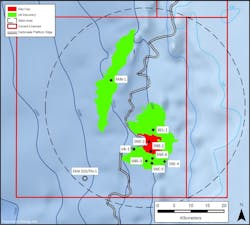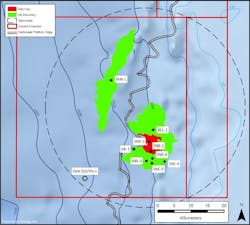Cairn-led group drills appraisal well in SNE field offshore Senegal
A combine led by Cairn Energy Ltd. has completed drilling of an appraisal well in SNE oil field offshore Senegal. The group recording strong flow rates in the SNE-6 well from the upper reservoirs.
Connectivity of these reservoirs has been established with the previous SNE-5 appraisal just 1.6 km away.
A drillstem test found that the main reservoir units, pressure data, and fluid contacts are in line with previous appraisal wells in the field. Samples recovered during the test indicate the oil is of similar quality across the field.
The first of two DSTs flowed from an 11-m interval at a maximum rate of 4,700 b/d of oil through a 60/64-in. choke. A 48-hr main flow period flowed at 3,700 b/d through a 52/64-in. choke.
The second test of an additional 12-m zone resulted in a maximum flow rate of 5,300 b/d through a 1-in. choke followed by a 24-hr flow period at an average flow rate of 4,600 b/d through a 52/64-in. choke.
Perth-based FAR Ltd., a member of the combine, says the SNE-5 and SNE-6 wells are sufficiently connected to optimize production of the S480 reservoirs with water flood-enhanced recovery techniques.
FAR said further analysis will take place once interference test data have been collected from all the observation wells, including SNE-3 and SNE-4, to determine the impact on modelled reservoir architecture, recoverable resource base, and forward development plan.
There is now sufficient data to get on with predevelopment work. The combine plans to submit a field development plan to the Senegal government next year.
The Stena Drilling Ltd. Stena DrillMAX rig is now moving to a pure exploration well: FAN South-1 in 2,139 m of water. The prospect lies to the southwest of SNE field and has two main objectives.
The first is an Upper Cretaceous-age stacked, multilayer, channelled turbidite fan. The second is the Lower Cretaceous base of the slope turbidite fan, which is equivalent to the FAN-1 oil discovery to the north made in 2014.

